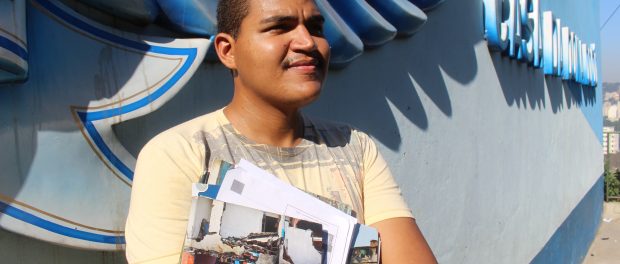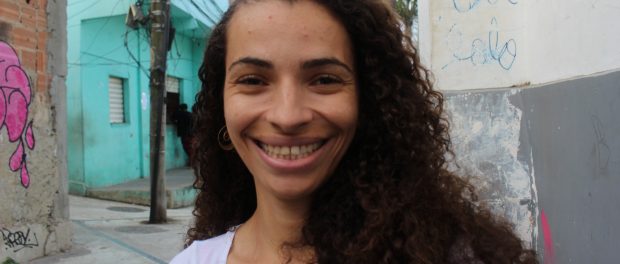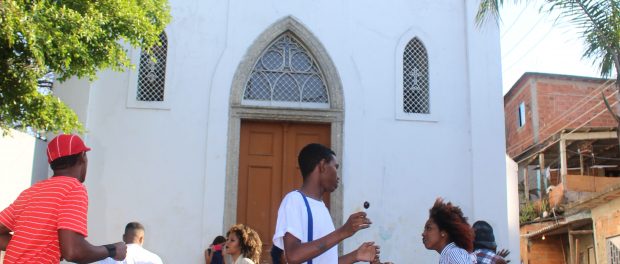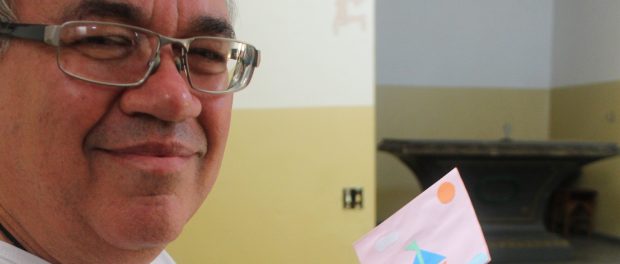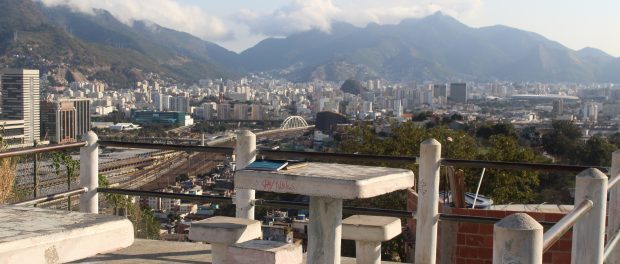
Providência, originally called Favela Hill, is officially Rio’s oldest favela. It will turn 120 next year and residents are working to maintain the community’s memories and history alive.
There are many ways to tell a story and there are many stories to tell. Cosme Felippsen, 27, uses the official and unofficial history of the city, gives performances and recites his poetry while he guides visitors through the Providência favela. His tour includes the paths created by Rio’s City government in 2005 for the so-called Museu à Ceu Aberto da Providência (Open Air Museum of Providência), as well as the paths chosen by him personally.
Cintia Sant’Anna, a 30-year-old actress, decided to tell stories of the favela through theater. After months of interviewing residents, she and other actors invited by the Bando Teatro Favela created and portrayed the oral histories in a play called Entre Becos e Vielas (Between Alleys and Alleyways).
Alexandre Lourenço, a 37-year-old resident of Cidade Nova, uses video as a tool to produce new narratives about the favela and the Port Region with the initiative Cine Providência.
Eron Cesar dos Santos, a 49-year-old biology graduate born and raised in Providência, is a self-taught historian and creator of the Providência Community Museum blog where, together with resident Roberto Marinho, he is spreading the community’s stories.
In this way, each one of them creates and recreates their own reservoir of memories about Brazil’s first favela: Morro da Providência.
Stories of yesterday and today on Cosme’s tour
“Before being called Morro da Providência, it was called Morro da Favela (Favela Hill). Before Morro da Favela, it was called Morro do Livramento (Rescue Hill). Before Morro do Livramento they were the lands of Senator Bento Barroso, which is why we have the Ladeira do Barroso (Barroso Slope),” says Cosme Felippsen, a resident and tour guide in Providência.
Cosme says that he was eight years old when he gave his first tour of the favela. It was in 1997 when they were celebrating the centenary of Brazil’s first favela from the original occupation of the hillside by ex-soldiers and camp followers from the Canudos War. A foreign couple asked Cosme to show them the alleyways in the favela. As payment, he was given a popsicle and at home his mother almost spanked him for having wandered off with strangers. In 2015, Cosme became a certified tour guide and he maintains the Providência Turismo Facebook page to schedule visits.
Among his materials for work, Cosme always carries the book SMH 2016: Removals in Olympic Rio de Janeiro in which he appears on pages 96 and 97, another of the artist Vhils who sculpted the faces of residents in the walls of their houses as an act against evictions, a handout about Evictions and Literature from a workshop that happened at the Evictions Museum in Vila Autódromo and a book by French photographer JR with various images of Providência, whose work initiated the NGO Casa Amarela. When there aren’t visits scheduled, Cosme sells pies and sweets at the Central do Brasil station and surrounding area nearby. He has two children and lives in an occupation on Ladeira do Faria.
“The City removed 50 families, but one family resisted and that resulted in other families going to re-occupy the empty space. The majority are people from Ceará who work at Central do Brasil. The rubble from the City’s evictions is still there today, and the residents themselves are removing it little by little,” says Cosme. “The Housing Secretariat should have changed its name to the Evictions Secretariat. They evicted more people than they housed. They wanted to remove 832 families. And how many houses did they build here? 34. Don’t you think they should have changed the name?”
Dramatizing memory and facing the everyday
An initiative of Cintia Sant’Anna, 30, the play Entre Becos e Vielas by the Bando Teatro Favela was staged following interviews with residents from Providência and was performed throughout the month of July in the Largo da Igreja square.
“It’s a very honest script. The three stories talk about the importance of honesty, of the solidarity that people have with each other and that we only experience within the community,” says Cintia.
Mônica Saturnino, 41, says they spent two months recording the audio with residents, over eight hours of recordings. “It’s a famous and historic hill, but we wanted to tell peoples’ stories. It’s not a historical account, it’s an emotional account. That’s what we call it,” Mônica affirms. “We used those stories as the basis for the show. We made fiction of the story. The people who were interviewed attended, felt moved, and liked it.”
Saturnino and Sant’Anna invited other actors from outside the favela to participate in the research and show. Thiago Viana, 28, resident of Morro da Conceição was one of them and he says it was delightful to hear the residents’ stories. “I very much like studies of historical content. This project gave me another line of action that had been little explored. The people always take the more well-known stories from Morro da Providência, or the most media friendly, and this project was the opposite of that. It was to find anonymous residents who weren’t in the same circles that everyone knows, and use those stories to create a drama. Sometimes people want to stage pieces by Machado de Assis, but the project wasn’t that.”
The most well-known stories remind us that Providência was the first favela in Brazil, famous for the childhood of writer Machado de Assis on the hill, samba people, Dona Dodô (flag-holder for the Portela samba school), the Carnival street parties, the removals, the construction of the cable car, the figure of the docker, the army and police actions on the hill–an emblematic example being the deaths of the youths who were arrested and sent to a rival gang faction in 2008.
The Pacifying Police Unit (UPP) was installed in Providência in 2010, but the army occupied the favela in 2006 after some military weapons were stolen. At that time, 11 favelas in Rio were occupied, including Providência, but the weapons were found in Rocinha.
Cintia recalls that although she has been doing theater for six years, it is the first time that the hill has had a theater group. Other initiatives didn’t last long and she recalls the difficulties encountered in creating the show: “Several times there were shootouts during rehearsals. Twice we didn’t perform the show because there was a police operation on the hill or because someone died. All of that messes with the day-to-day and we live in that day-to-day. It’s not like a standard theater run,” Cintia says. “Maintaining a group is very difficult and the territory is very unique for all the reasons people know about. Now everyone wants to live in a favela, it’s in style. But the guy doesn’t actually live in the favela and doesn’t know what it really is, sometimes, to not be able to go home because of a shootout, taking it hard from the police.”
The story on the big screen: cinema on the hill
It was through a course in culture that Alexandre Lourenço, 37, approached the hill and created Cine Providência, a project championed by the Rio Municipal Culture Secretariat.
Recently, he produced the short film Olhares da Providência for the 72h Festival. During the last presentation of Cine Providência in July, residents were excited to recognize neighbors and places on the big screen. According to Alexandre, the film club archive has close to 120 short films produced in the Port Region and he is finalizing a feature film about the Vizinha Faladeira samba school.
Alexandre affirms that he has also been working with memory by conducting research about the samba school at the National Library and the National Archive, as well as interviewing ex-participants of the school: “You have to dig around a lot to find the roots of the school, since it spent 50 years without activity. You have to find residents who don’t live here anymore. I found relatives of the school’s founders, for example, in Campo Grande. It’s a lot of work, but it’s gratifying.”
The documentary filmmaker affirms that Vizinha Faladeira is one of the oldest samba schools in Brazil and brought a series of innovations utilized in the schools like the children’s wing and the front commission, for example. The school was in Group C of this year’s Carnival parades. Vizinha Faladeira was created by rogues from Santo Cristo in homage to neighbors who observed all their lives: “There were two neighbors from the alleyway, on Rua da América, who always gossiped. Going back, the school’s symbol was an old lady with a huge tongue. Now it’s a mermaid,” states Alexandre.
Legends and stories from Providência
Eron Cesar dos Santos, 49, is the janitor at the Nossa Senhora da Penha church. His parents took care of the space since 1973 and he has taken care of it since they passed away. He is a master in the Grupo Ventre Livre capoeira group which he’s been part of for over 20 years. Beyond receiving and guiding visitors around the hill, Eron collects ghost stories of the favela.
According to stories passed down from generation to generation of residents, there is Iron Foot, a former slave who roams the hillside in the early hours dragging chains and there is also a bundle of clothes that rolls out of the chapel, where many washers worked, and wraps around the first resident in its path, stealing the resident’s soul. The Nossa Senhora da Penha church is also full of those kinds of stories.
“In the old days, the church didn’t have electricity. Then, one resident turned and said ‘Whoa, the Cruzeiro church is illuminated, it’s beautiful.’ Then the other resident noted: ‘Wait, but there’s no electricity there.’” Eron laughs as he tells the story. “At Nossa Senhora da Penha, people also saw a wedding party leave around midnight… Suddenly, all the lights went out and the party was over.”
The janitor tells the scary stories with a smile and recalls that he himself also experienced an event. When he tutored kids after school, he and a student heard someone walking up the steps of the church, from the first step to the last: “I thought I was going crazy, and we both heard it,” Eron assures.
The Church survives on donations, but support for maintenance has been minimal and Eron doesn’t receive payment to look after the place. In addition to being the janitor, a capoeira teacher and a tutor, Eron is a historian of the hillside and around two years ago created a virtual community museum: Morro da Providência Community Museum. This effort to preserve local memory is still in its initial stages but it also counts on the participation of another resident, Roberto Marinho, whose family has lived there for generations.
“Providência for me means life. It is my history, my space. It is where I was born and the place where I grew up. It is where my son was born. I want to leave a legacy for him and I hope that one day he leaves it for his children too,” concludes Eron.

